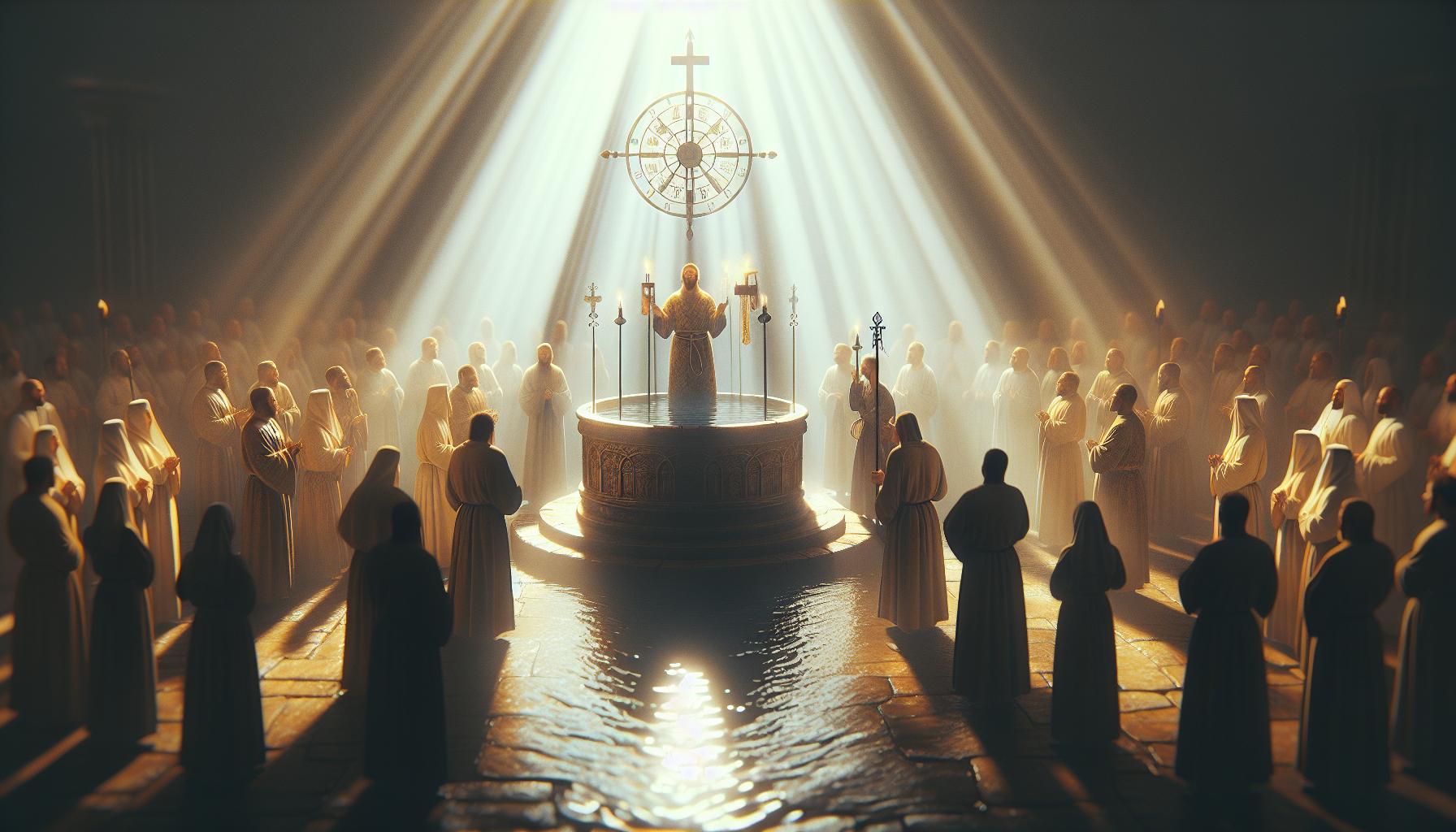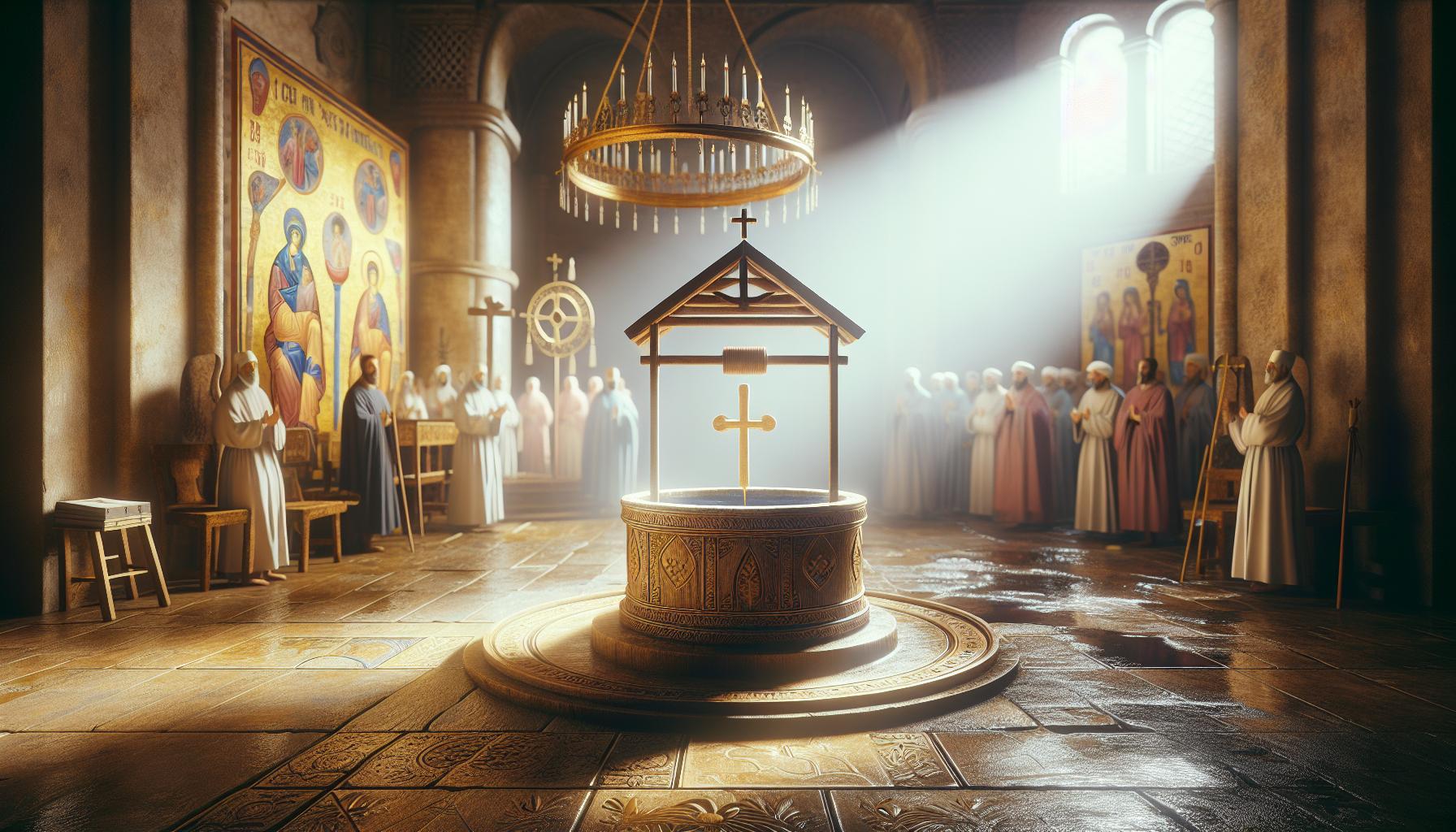Throughout history, various locations have served as sanctuaries for sacred rituals, and the question of whether baptism can occur in wells is both intriguing and historically significant. Understanding these unconventional baptismal sites reveals the evolution of religious practices and their deep-rooted connections to cultural traditions, making this exploration pertinent for both scholars and the curious alike.
The Significance of Baptism: Understanding Its Spiritual Essence
Baptism serves as a cornerstone in many faith traditions, embodying a significant rite of passage that transcends mere ritual. As individuals and communities engage in this sacred act, they affirm their beliefs and enter into a communal relationship with the divine. Historical practices, such as receiving baptisms in wells, illustrate the diverse settings where this event has taken place, shaping its meaning and significance across cultures and eras.
The Spiritual Essence of Baptism
Baptism is imbued with deep spiritual meaning that goes beyond physical immersion in water. It symbolizes purification, rebirth, and the embarkation on a spiritual journey. Here are key aspects that highlight its essence:
- Symbol of Cleansing: The act of being submerged or sprinkled with water represents the washing away of sins, reflecting the believer’s desire for spiritual renewal.
- Initiation into Faith: Baptism marks the entry into a particular faith community, as individuals publicly declare their beliefs and commit themselves to living a life aligned with those tenets.
- Connection to the Divine: Through baptism, individuals experience a profound connection to the divine, often feeling a sense of being spiritually reborn.
- Historical Continuity: Practices like baptisms in wells connect modern believers to centuries of tradition, showcasing the ongoing relevance of this sacred rite.
Particularly notable in the context of historical baptismal locations, wells served not just as practical sources of water but also as sacred spaces where communities gathered to witness and participate in these fundamental rituals. These sites often held communal significance, fostering connections among participants that transcended time and space.
The Role of Historical Context in Understanding Baptism
Exploring how cultural practices have integrated baptism reveals its transformative power. For example, in ancient times, people often sought out natural bodies of water, such as lakes and wells, for baptism, infusing the rite with both spiritual and environmental significance. These locations were imbued with rich symbolism, representing life and fertility, echoing the life-giving essence of water.
| Historical Location | Significance | Modern Interpretation |
|---|---|---|
| Jordan River | Site of Jesus’ baptism | Symbol of new beginnings |
| Baptismal Wells | Cultural communal rituals | Personal and community renewal |
| Cathedrals | Formal initiation into the Church | Structured, faith-based communities |
Understanding the spiritual essence of baptism allows individuals to appreciate the layers of meaning that this practice holds within different contexts. Whether one is immersed in a river, sprinkled at a font, or baptized in ancient wells, the core significance remains—a unique blend of initiation, connection, and spiritual rejuvenation that continues to resonate across generations.
Wells as Sacred Spaces: A Historical Perspective on Baptismal Practices
Throughout history, wells have often been seen as more than just sources of water; they have served as vital symbols of life, purity, and spiritual renewal. The significance of wells as sacred spaces has permeated various cultures, often intertwining with religious practices. In many civilizations, the act of baptism, a ritual signifying purification and initiation into a faith, has been performed at these natural sites, raising an intriguing question: do people receive baptisms in wells? Understanding this practice offers a fascinating glimpse into historical baptismal locations and the cultural lenses through which they are viewed.
The Symbolism of Wells in Ancient Cultures
Wells have historically held a prestigious place in many societies, often viewed as gateways to the divine. They were associated with life-giving properties, not only providing water but also symbolizing inner strength and spiritual cleansing. In ancient Rome, for example, the practice of immersion in wells was common among certain cults, which believed these waters had healing properties. Similarly, in Celtic traditions, wells were revered as sacred spaces where offerings were made, and vows were taken, reinforcing their importance within local spiritual practices.
- Healing Powers: Many cultures attributed magical properties to well water, believing it could heal ailments and soothe the soul.
- Ritual Purity: Wells often served as sites for purification rituals, marking an individual’s transition from the mundane to the sacred.
- Community Gathering: These locations frequently became communal sites where spiritual and social gatherings occurred, blending the sacred with the social.
Baptismal Practices in Historical Context
The intersection of wells and baptismal rituals is evident in numerous historical accounts. In early Christianity, for instance, the practice of baptism by immersion was commonplace, often conducted in rivers or wells. This form of baptism symbolized not only the washing away of sin but also underlying connections to eternal life and divine grace. Notable figures from church history, such as John the Baptist, famously performed baptisms in rivers, illustrating how water sources were central to the ministry.
| Culture/Group | Site Type | Baptismal Significance | Notable Practices |
|---|---|---|---|
| Early Christians | Wells/Rivers | Purification and Initiation | Immersion baptism |
| Celtic Tribes | Sacred Wells | Spiritual Renewal | Offerings and Vows |
| Roman Cults | Natural Springs | Healing and Rebirth | Ritual Immersion |
Throughout various traditions, wells have maintained their significance as baptismal venues, reinforcing the idea that these sacred spaces are deeply intertwined with personal and communal spirituality. As we reflect on baptismal practices in wells, it becomes clear that these historical baptismal locations are not merely geographic points but also rich tapestries of cultural meaning, connecting humanity’s quest for purity and divine connection through the ages.
Ancient Traditions: How Early Christians Used Natural Water Sources
In the earliest days of Christianity, the use of natural water sources for baptisms was not merely a ritual but a profound expression of faith and community identity. Early Christians often gathered at rivers, lakes, and wells, believing these locations to be infused with spiritual significance and purity. This reliance on the natural world for sacred rites connected them deeply to the earth and their Creator, making each baptism an event rich in symbolism and community engagement.
Importance of Natural Water Sources
Natural water sources held a dual importance for early Christians. Firstly, they represented the life-giving properties of water, echoing key biblical themes of renewal and salvation. Water was seen not just as a physical element, but as a metaphor for spiritual rebirth and cleansing—concepts highlighted in scripture. Secondly, these locations fostered community, as baptisms would often draw groups of believers who shared in the joy and significance of the event. Gathering by a river or well transformed a personal commitment into a communal celebration, reinforcing the bonds of fellowship.
Historical Practices Around Baptism
The practice of utilizing various natural settings for baptism reflected diverse local customs, resulting in distinctive approaches around the early Christian world. Here are some notable practices:
- Rivers and Streams: Many early Christians preferred to be baptized in rivers, believing the flowing water represented the flow of divine grace. The River Jordan was particularly revered as the site of Jesus’ own baptism.
- Wells: Local wells often served as sites for initiation, especially in areas where rivers were not accessible. These wells were seen as places of hidden depth, mirroring the profound transformation that baptism symbolized.
- Sea and Lakes: In coastal regions, the sea provided a dramatic backdrop for baptisms, where waves crashing against the shore echoed the monumental change in a spiritual journey.
| Water Source | Significance | Region Used |
|---|---|---|
| Rivers | Flowing grace | Middle East, Europe |
| Wells | Depth and purity | Local communities |
| Seas and Lakes | Majesty of creation | Coastal regions |
In understanding how early Christians engaged with these natural water sources, we appreciate the profound depth of their rituals. Baptism was more than a mere act; it was a reflection of their relationship with nature, their faith, and each other. As we explore historical baptismal locations further, the significance of these rituals within the context of community and spirituality becomes increasingly relevant.
The Symbolism of Water: A Deeper Dive into Baptismal Meaning
Water has long been a powerful symbol across cultures and religions, acting as a conduit for transformation and renewal. In the context of baptism, especially in historical settings like wells, it embodies not only cleansing but also the promise of new life. This sacred act, often performed in locations steeped in tradition, illustrates the multifaceted nature of water as a sacred symbol that transcends mere physicality.
The Multifaceted Symbolism of Water
Throughout history, water has represented various themes across different spiritual traditions:
- Purification: Water is universally associated with cleansing, washing away impurities and sin, embodying the idea of a fresh start.
- Life and Fertility: Water is essential for life, and its presence often signifies growth and fertility, linking it to the creation narratives found in many religions.
- Transformation: Much like how raw materials can be transformed into something beautiful, water symbolizes the change that occurs within individuals during the baptismal process.
- Continuity: Water flows and replenishes, signifying the continuous nature of life, faith, and community. This aspect underscores the reason why many choose historical baptismal locations, as they connect fervent belief with enduring legacy.
The choice of wells for baptism is particularly evocative. In historical contexts, the presence of a well not only provided physical sustenance but also served as a portal to the spiritual. These locations were often seen as sacred spaces, creating an atmosphere conducive to deep reflection and solemn commitment. The act of baptism in a well signifies a profound journey, where the immersion into water symbolizes the believer’s entry into faith and the collective narrative of their community.
Water in Baptismal Rituals: Real-World Connection
Engaging with water during baptism is not just a ceremonial act; it holds deeper meaning and connection to the individual’s spiritual journey. For example, when congregations gather at historical wells, they often reflect on the stories of faith that those waters have seen throughout the centuries. This experiential aspect enhances their understanding of baptism as not merely a ritual but as an invitation into a larger communal legacy.
| Aspect | Significance |
|---|---|
| Purification | Signifies the cleansing of sin and the preparation for a new life in faith. |
| Community | Reinforces bonds among believers through shared experiences in sacred locations. |
| History | Connects the individual to the tradition and transformation of past generations. |
| Spiritual Journey | Represents the personal commitment to a faith that is both ancient and contemporary. |
By immersing oneself in the waters of a well, individuals not only partake in a historical ritual but also connect their personal transformation with the tides of faith that have flowed through time. In this way, the symbolism of water during baptism underscores its vital role in both individual and communal spiritual narratives, reminding us that we are part of a vast, living story that continues to flourish in every drop.
Modern Resurgence: Are Wells Making a Comeback in Baptismal Rituals?
As water has long held spiritual significance, the practice of baptism has evolved dramatically throughout history. Today, the resurgence of wells as venues for baptismal rituals reflects a growing interest in reconnecting with ancient traditions and the symbolism that these sacred sites embody. In many regions, churches are beginning to embrace the idea that these natural sources of water can provide a deeply immersive and spiritually enriching experience for new believers.
Historical Significance of Wells in Baptism
Throughout centuries, wells have served as vital sources of water for communities, but their role in spiritual rites is equally profound. Many early Christians viewed wells as places of divine encounter, where the faithful could not only quench their thirst but also experience spiritual renewal. As we delve into the historical baptismal locations, we discover that wells often carried rich theological significance, representing purification, rebirth, and connection to the divine.
– Symbolism of Water: In various cultures, including Christianity, water symbolizes cleansing and transformation. Wells, being deep and often hidden, represent the journey one must undertake to connect with their inner self and faith.
– Historical Context: Many ancient churches were built around existing wells, indicating the importance of these sites. By immersing in well water during baptism, individuals could link their personal rebirth to the profound history of their faith.
Contemporary Practices Reviving Traditional Baptismal Sites
In recent years, a growing number of churches and congregations are beginning to reintroduce wells into their baptismal rituals, seeking to enhance the spiritual experience for participants. This modern resurgence is part of a broader trend towards valuing experiential and meaningful practices in faith communities.
- Community Engagement: Many churches invite congregants to participate in the revival of rituals, where community members gather at local wells to witness and partake in baptismal ceremonies.
- Nature Connection: Using natural sources aligns with a growing desire for ecological consciousness within religious practices, fostering an appreciation for creation.
For example, a church in rural Pennsylvania has converted an abandoned well into a baptismal site. This initiative has not only revived the historical ambiance of the site but also reignited community interest in faithful practices that honor their past.
Considerations for Integrating Wells into Baptismal Rituals
When considering the integration of wells into baptismal rituals, it is crucial to approach the transition thoughtfully. Here are some actionable steps congregations can take:
| Step | Description |
|---|---|
| Research Local Wells | Identify historical or natural wells in your area that have cultural significance. |
| Engage the Community | Hold discussions or surveys within your congregation to assess interest in utilizing these sites. |
| Plan the Ritual | Develop a baptismal ceremony that incorporates traditions associated with wells, emphasizing their historical importance. |
| Education and Awareness | Provide resources and teachings about the significance of wells in baptismal practices, fostering deeper understanding and respect. |
By revisiting the role of wells in baptismal rituals, communities are not only reconnecting with their heritage but are also offering a potent symbol of faith, renewal, and connection to both nature and tradition. Whether it’s through grassroots initiatives or church-led programs, the revival of this ancient practice celebrates the profound bond between spirituality and the elemental nature of water.
Diverse Denominational Perspectives: Baptism Practices Across Faiths
The practice of baptism spans across numerous faiths, each interpreting the significance and method of this spiritual rite in diverse and rich ways. While some cultures integrate unique geographical features—like wells—into their baptismal traditions, others adhere to more conventional practices, leading to fascinating variations in the understanding and execution of this sacred ceremony.
Christian Denominations and Their Perspectives
In Christianity, baptism holds a central role as a sacrament and rite of initiation. However, the approach to baptism can differ significantly across denominations:
- Catholicism: Baptism is seen as a path to salvation, often performed on infants to cleanse original sin. The ritual includes the use of holy water, which symbolizes purification.
- Protestantism: Various branches, such as Baptists and Methodists, emphasize believer’s baptism, advocating for those old enough to understand the commitment to faith. They may use immersion in a river, lake, or even wells.
- Orthodoxy: In Orthodox traditions, baptism is conducted through full immersion thrice, which symbolizes the Holy Trinity. Wells, being natural sources of water, may serve as appropriate locations in some communities.
The practice of baptism in wells is a striking example of how local customs can influence faith practices. Historically, wells have served as gathering places, often believed to hold spiritual significance due to their life-giving water. Many cultures, not just Christians, have sought these sacred sites for rites and rituals, invoking the earth’s inherent power in their spiritual practices.
Other Faith Traditions Incorporating Water Rites
Water has long been regarded as a symbol of purification and rebirth across various religions and spiritual paths. Some notable examples include:
| Faith Tradition | Baptismal Practice |
|---|---|
| Judaism | Using a mikveh, or ritual bath, for spiritual purification, which precedes significant life events. |
| Hinduism | Ritual bathing in sacred rivers, such as the Ganges, to cleanse and purify the soul. |
| Islam | Although not termed baptism, the practice of Wudu, which involves washing certain body parts, symbolizes purification before prayer. |
These practices not only reflect the spiritual importance of water but also serve as communal rites, fostering a deeper connection among participants. The diversity in baptism practices emphasizes the richness of faith expressions and highlights how water remains a crucial element across traditions in marking significant spiritual milestones. Exploring these various perspectives enriches one’s understanding and appreciation of baptism’s integral role in the spiritual journey.
Practical Considerations: Conducting Baptisms in Wells Today
As more congregations seek meaningful ways to connect with their heritage, the practice of conducting baptisms in wells—a method with deep historical roots—has seen a revival. This approach not only enriches the ceremonial experience but also invites congregants to partake in a ritual that echoes the ancient practices of their faith. However, organizing such ceremonies today requires a thoughtful consideration of both practical and spiritual elements.
Choosing the Right Well
Identifying an appropriate location to conduct baptisms is crucial. Several factors play into selecting the ideal well for this sacred ritual:
- Water Quality: Ensure the water in the well is clean and safe for immersion. Regular testing for contaminants can help guarantee the health of those being baptized.
- Accessibility: The well should be easily reachable for participants, including those with mobility challenges. Consider the location of the well in relation to where the majority of your congregation resides.
- Historical Significance: Look for wells with historical backgrounds that may enhance the baptism experience. Using wells recognized for their significance can foster a deeper connection to the tradition.
Preparing for the Ceremony
Preparation is key to ensuring a smooth and respectful baptism ceremony. Here are some actionable steps to consider:
- Permitting and Local Regulations: Before proceeding, check with local authorities to ensure that the well can be used for ceremonial purposes. Some areas may have restrictions or require permits.
- Creating a Spiritual Atmosphere: Decorate the space around the well with flowers, candles, or other symbols of faith to create a reverent mood. You may even include scripture readings or music that align with the significance of the ceremony.
- Designating Roles: Assign specific responsibilities to clergy and volunteers, such as ensuring participants are prepared and guiding them through the baptismal process, enhancing the overall experience.
Post-Ceremony Considerations
After the baptism, there are several elements to address:
- Celebratory Gathering: Consider hosting a gathering post-ceremony where attendees can reflect on the experience, enhancing community bonds and celebrating the spiritual commitment made.
- Documentation: Keep a record of those baptized, noting the date and context. This is invaluable for church records and can serve as a cherished keepsake for families.
- Follow-Up Engagement: Ensure to follow up with recently baptized individuals or families, inviting them to further participate in church activities, strengthening their ties to the community.
Incorporating baptisms in wells into modern practices encourages a rich interplay between tradition and contemporary worship. Emphasizing both the historical significance and the practical aspects of conducting such a ceremony ensures that the revitalization of this sacred rite is both meaningful and enduring.
Personal Reflections: Stories and Experiences from Wells Used for Baptism
The practice of baptism holds significant spiritual weight in various cultures and religions, often symbolizing purification and the initiation of one into a faith community. Interestingly, historical baptismal locations, such as wells, have served not just as ceremonial spots but as venues rich with personal stories and experiences. The resonating echoes of laughter, joy, and sometimes even tears can still be felt around these age-old sites, as individuals reflect on the transformative journeys they embarked upon during their sacred ceremonies.
Experiences Shared by the Community
Many individuals have delightful memories surrounding the use of wells for baptism, carrying with them the stories that bind families and communities. Here are some captivating anecdotes illustrating the profound experiences associated with these baptismal locations:
- The Old Stone Well: In a quaint village, a centuries-old stone well became a cherished location for community baptisms. Generations have stood near this well, excitedly awaiting the moment when loved ones emerged from the water fully immersed and renewed. One participant recalls her father’s baptism there, stating, “The joy on his face as he was lifted out of the water is a memory etched in my heart forever.”
- Reviving Traditions: A modern family sought to connect with their ancestral roots by choosing a well for their child’s baptism. They were inspired by stories of their great-grandparents who similarly received their baptisms from this very site. The experience was not only spiritual but also educational, as they spent the evening with family, recounting the rich history of their lineage.
- Environmental Reflection: Another touching story comes from a community that turned to a local well surrounded by nature, emphasizing their respect for creation during the baptismal rite. One mother emphasized how the tranquility of the natural environment allowed them to engage more deeply in the ceremony, saying, “It felt like the earth itself was participating with us in this sacred moment.”
The Significance of Place in Faith
The connection between physical sites and spiritual experiences reveals how places of baptism in wells can profoundly impact personal faith journeys. These historical baptismal locations not only highlight relational ties within families but also encourage reflections on communal heritage and spiritual commitments. Choosing a well as a baptismal site can enhance the spiritual significance of the event, allowing participants to draw upon centuries of tradition while creating new memories intertwined with their faith.
Many who have experienced baptisms in wells affirm that the location itself amplifies the spiritual significance of their rite. The cool, refreshing water is not just a medium for cleansing but a symbol of life and rebirth, reinforcing the emotional and spiritual weight of the event. As we reflect on the stories shared, it’s evident that these historical baptismal locations offer more than a traditional setting—they become sacred grounds where faith experiences are made tangible and personal.
FAQ
Do People Receive Baptisms in Wells: Historical Baptismal Locations?
Yes, many people have historically received baptisms in wells, which were often viewed as sacred places. These locations provided a spiritually significant setting where individuals could symbolize their renewal and commitment to faith.
Wells have been associated with water’s purification properties, making them an ideal choice for baptism. Throughout history, many cultures regarded wells as gateways to spiritual enlightenment, thus they became popular baptismal sites, especially in regions rich in Christian heritage. For a deeper understanding, you can explore historical baptismal practices in various traditions.
What is the significance of wells in baptismal traditions?
The significance of wells in baptismal traditions stems from their representation of spiritual rebirth. Water symbolizes cleansing and renewal, making wells powerful symbols in various religious contexts.
In many faiths, including Christianity, the act of baptism signifies a fresh start or a new life in the faith community. This act is often performed in natural water sources like wells, emphasizing the connection to nature and its spiritual importance. You can find more about different baptismal traditions in our linked resources.
Why does baptism in a well hold historical importance?
Baptism in a well holds historical importance because it connects believers to ancient practices of using natural water for sacred rituals. This tradition underscores the historical relevance of water in spiritual life.
Historically, wells were thought to be places of divine presence, where individuals could rejuvenate both physically and spiritually. This made them perfect for baptism ceremonies, allowing for a tangible encounter with the divine. The significance of these rituals can vary widely, reflecting the diverse theological understandings across denominations.
Can I be baptized in a well today?
Yes, it is possible to be baptized in a well today, though it often depends on local church traditions and the availability of suitable wells. Many congregations are open to such experiences, emphasizing the importance of convenience and spiritual significance.
Before pursuing a baptism in a well, it’s vital to consult with your church leaders, as they can provide guidance on the process and any necessary preparations. Churches may also facilitate these baptisms in historically relevant sites that hold personal significance to participants.
How do historical baptismal locations enhance spiritual experiences?
Historical baptismal locations enhance spiritual experiences by connecting individuals with the rich heritage and traditions of their faith. These sites often carry deep significance, allowing participants to feel the weight of the rituals practiced by their ancestors.
Being baptized in a historically significant place can enrich the meaning behind the ceremony, as participants reflect on the continuity of faith through generations. These locations serve as a reminder of one’s spiritual journey, deepening the emotional and spiritual experience of baptism.
What are some notable historical wells used for baptism?
Notable historical wells used for baptism include the Jordan River, traditional sites in England, and various wells in ancient church traditions across Europe. These wells are marked by their history and spiritual significance in various Christian communities.
For example, the Jordan River is famously known as the site of Jesus’s baptism, making it a pilgrimage spot for many Christians. Additionally, wells like those found in Celtic Christianity were often used for baptism, showing the diversity of practices in historical Christianity.
Why are baptismal practices varied across different denominations?
Baptismal practices vary across denominations due to theological interpretations, cultural contexts, and traditions. Each denomination emphasizes different aspects of baptism, shaping how they perform this sacred act.
For instance, some traditions stress immersion in water as a sign of complete renewal, while others practice sprinkling or pouring. This diversity reflects differing beliefs about the role of baptism in the faith journey, but at its core, baptism remains a celebrated rite across the Christian community.
The Conclusion
As we conclude our exploration of historical baptismal locations, particularly the intriguing practice of baptisms in wells, it’s evident that the act of baptism transcends mere ritual. It serves as a profound expression of faith, community, and spiritual rebirth across diverse traditions. Reflecting on the historical significance of wells not only enriches our understanding of baptismal practices but also invites us to appreciate the sacred spaces that have facilitated these vital moments in believers’ lives.
Whether you come from a tradition that emphasizes immersion, sprinkling, or another method, the essence of baptism remains a transformative experience meant to connect us all. We encourage you to dive deeper into your own tradition’s understanding of baptism, perhaps considering how historical practices influence current beliefs and practices.
Join us in further exploration, sharing your thoughts, experiences, and questions about baptism and its many forms. Engage with your faith community or explore local historical sites connected to these sacred rituals. Together, we can appreciate the diversity of beliefs while strengthening our shared commitment to spiritual growth and understanding. Your journey into the depths of baptism—and what it means for you—has only just begun.





